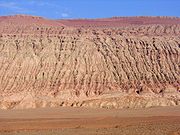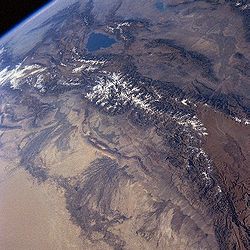
Flaming Mountains
Encyclopedia

Gaochang
Gaochang is the site of an ancient oasis city built on the northern rim of the inhospitable Taklamakan Desert in Xinjiang, China. A busy trading center, it was a stopping point for merchant traders traveling on the Silk Road...
Mountains are barren, eroded, red sandstone
Sandstone
Sandstone is a sedimentary rock composed mainly of sand-sized minerals or rock grains.Most sandstone is composed of quartz and/or feldspar because these are the most common minerals in the Earth's crust. Like sand, sandstone may be any colour, but the most common colours are tan, brown, yellow,...
hills in Tian Shan Mountain range
Tianshan
Tianshan may refer to:*Tian Shan, a mountain range in Central Asia*Tianshan District, Ürümqi, Xinjiang, China*Tianshan Subdistrict, Ar Horqin Banner, Inner Mongolia, China*Tianshan Town, Ar Horqin Banner, in Ar Horqin Banner, Inner Mongolia, China...
, Xinjiang
Xinjiang
Xinjiang is an autonomous region of the People's Republic of China. It is the largest Chinese administrative division and spans over 1.6 million km2...
, China. They lie near the northern rim of the Taklamakan Desert and east of the city of Turpan. Their striking gullies and trench
Trench
A trench is a type of excavation or depression in the ground. Trenches are generally defined by being deeper than they are wide , and by being narrow compared to their length ....
es have been etched by years of volcanic activity that caused molten lava
Lava
Lava refers both to molten rock expelled by a volcano during an eruption and the resulting rock after solidification and cooling. This molten rock is formed in the interior of some planets, including Earth, and some of their satellites. When first erupted from a volcanic vent, lava is a liquid at...
to course down the mountainsides, giving the mountains a flaming appearance at certain times of the day.
The mountains are approximately 100 kilometres (62.1 mi) long and 5–10 km (3.1–6.2 mi) wide and cross the Tarim Basin
Tarim Basin
The Tarim Basin is a large endorheic basin occupying an area of about . It is located in the Xinjiang Uyghur Autonomous Region in China's far west. Its northern boundary is the Tian Shan mountain range and its southern is the Kunlun Mountains on the northern edge of the Tibetan Plateau. The...
from east to west. The average height of the Flaming Mountains is 500 m (1,640.4 ft), with some peaks reaching over 800 m (2,624.7 ft). The mountain climate is harsh, and the extremely high summer temperatures make this the hottest spot in China, frequently reaching 50 °C (122 °F) or higher. One of the largest thermometers in China—a popular tourist spot—is on display adjacent to the mountain, tracking the surrounding air temperature.
Silk route


Southeast Asia
Southeast Asia, South-East Asia, South East Asia or Southeastern Asia is a subregion of Asia, consisting of the countries that are geographically south of China, east of India, west of New Guinea and north of Australia. The region lies on the intersection of geological plates, with heavy seismic...
and oasis towns such as Gaochang
Gaochang
Gaochang is the site of an ancient oasis city built on the northern rim of the inhospitable Taklamakan Desert in Xinjiang, China. A busy trading center, it was a stopping point for merchant traders traveling on the Silk Road...
, built at the foot of the Flaming Mountains on the desert's rim near an important mountain pass, became respite stops for traveling merchant traders.
Buddhist missionaries often accompanied traders on busy international trading routes
Trade route
A trade route is a logistical network identified as a series of pathways and stoppages used for the commercial transport of cargo. Allowing goods to reach distant markets, a single trade route contains long distance arteries which may further be connected to several smaller networks of commercial...
and during the times trade boomed on the Silk Route, Buddhist monasteries and temples were built in the busy trading centers and in nearby remote mountain spots.
The Bezeklik Thousand Buddha Caves
Bezeklik Thousand Buddha Caves
The Bezeklik Thousand Buddha Caves are complex of Buddhist cave grottos dating from the 5th to the 9th centuries between the cities of Turpan and Shanshan at the north-east of the Taklamakan Desert near the ancient ruins of Gaochang in the Mutou Valley, a gorge in the Flaming Mountains, China...
site lies in a gorge under the cliffs of the Flaming Mountains near the pass by Gaochang. It is a complex of seventy Buddhist cave grottoes dating from the 5th to the 9th centuries CE, many with thousands of mural
Mural
A mural is any piece of artwork painted or applied directly on a wall, ceiling or other large permanent surface. A particularly distinguishing characteristic of mural painting is that the architectural elements of the given space are harmoniously incorporated into the picture.-History:Murals of...
s of Buddha
Gautama Buddha
Siddhārtha Gautama was a spiritual teacher from the Indian subcontinent, on whose teachings Buddhism was founded. In most Buddhist traditions, he is regarded as the Supreme Buddha Siddhārtha Gautama (Sanskrit: सिद्धार्थ गौतम; Pali: Siddhattha Gotama) was a spiritual teacher from the Indian...
.
Literary fame
The Flaming Mountains received their name from a fantasy account of a Buddhist monkMonk
A monk is a person who practices religious asceticism, living either alone or with any number of monks, while always maintaining some degree of physical separation from those not sharing the same purpose...
, accompanied by a Monkey King with magical powers, who runs into a wall of flames on his pilgrimage to India
India
India , officially the Republic of India , is a country in South Asia. It is the seventh-largest country by geographical area, the second-most populous country with over 1.2 billion people, and the most populous democracy in the world...
in the popular 16th century novel, Journey to the West
Journey to the West
Journey to the West is one of the Four Great Classical Novels of Chinese literature. It was written by Wu Cheng'en in the 16th century. In English-speaking countries, the tale is also often known simply as Monkey. This was one title used for a popular, abridged translation by Arthur Waley...
, by Ming Dynasty
Ming Dynasty
The Ming Dynasty, also Empire of the Great Ming, was the ruling dynasty of China from 1368 to 1644, following the collapse of the Mongol-led Yuan Dynasty. The Ming, "one of the greatest eras of orderly government and social stability in human history", was the last dynasty in China ruled by ethnic...
writer, Wu Cheng'en
Wu Cheng'en
Wu Cheng'en , courtesy name Ruzhong , pen name "Sheyang Hermit," was a Chinese novelist and poet of the Ming Dynasty, best known for being the attributed author of one of the Four Great Classical Novels of Chinese literature, Journey to the West.-Biography:Wu was born in Lianshui, in Jiangsu...
. The novel is an embellished description of the monk Xuanzang
Xuanzang
Xuanzang was a famous Chinese Buddhist monk, scholar, traveler, and translator who described the interaction between China and India in the early Tang period...
who traveled to India in 627 CE to obtain Buddhist scriptures and went through a pass in the Tien Shan after leaving Gaochang.
Legends
According to an old HanHan Dynasty
The Han Dynasty was the second imperial dynasty of China, preceded by the Qin Dynasty and succeeded by the Three Kingdoms . It was founded by the rebel leader Liu Bang, known posthumously as Emperor Gaozu of Han. It was briefly interrupted by the Xin Dynasty of the former regent Wang Mang...
legend, the Monkey King created a disturbance in the heavens and knocked over a kiln, causing embers to fall from the sky to the place where the Flaming Mountains are now. In an Uigur legend, a dragon
Dragon
A dragon is a legendary creature, typically with serpentine or reptilian traits, that feature in the myths of many cultures. There are two distinct cultural traditions of dragons: the European dragon, derived from European folk traditions and ultimately related to Greek and Middle Eastern...
lived in the Tianshan Mountains. Because the dragon ate little children, an Uigur hero slew the dragon and cut it into eight pieces. The dragon's blood turned into a scarlet mountain of blood and the eight pieces became the eight valleys in the Flaming Mountains.

